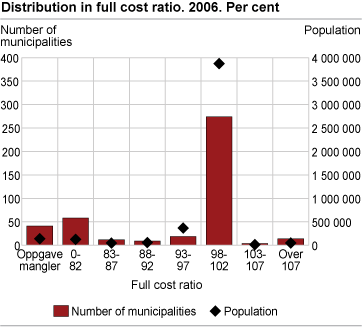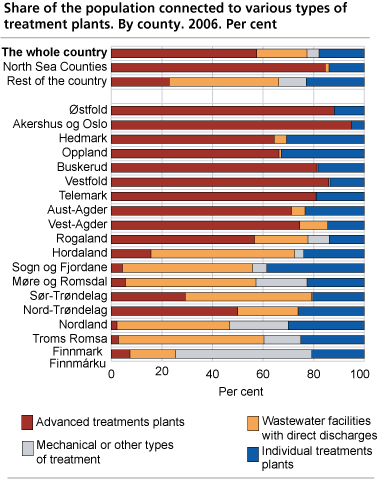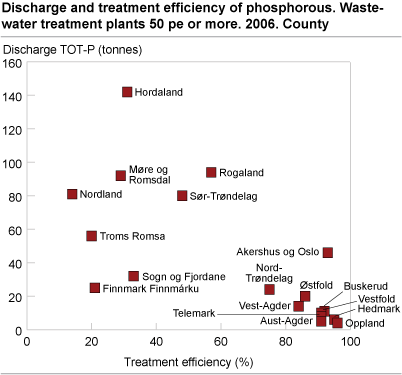Content
Published:
This is an archived release.
Lower fees in populous municipalities
More than half of Norway’s inhabitants live in municipalities that charge NOK 2 000 or less for wastewater distribution per year. The average annual fee was NOK 2 560 in 2007. This means that sparsely populated municipalities charge higher fees than densely populated municipalities.
All municipalities have the same weighting when the average figures are calculated. The average annual fee of NOK 2 560 is an increase of 3 per cent from last year. The annual fee varies from NOK 376 to NOK 5 554. If the municipalities were weighted according to population density, the average would be reduced to NOK 2 136. This indicates that sparsely populated municipalities on average have a slightly higher annual fee than densely populated municipalities.
Some users pay for the actual amount of discharged wastewater. The average fee per cubic metre was NOK 10.86 in 2007. On average, this type of fee is slightly higher than the average for all municipalities.
Variations in fees
Wastewater fees are determined by the municipalities in accordance with the full cost principle. Local conditions such as topography, the need for pumping stations and population density are factors behind the variation in fees.
The connection fee varies from zero to NOK 60 006. Together, the annual fee and connection fee cover the municipalities’ wastewater costs. Looking at municipalities and their population size, it is evident that municipalities with a medium population size have the highest connection fee, whilst the largest municipalities have the lowest connection fee. The exception is Oslo, which has a higher connection fee than the average fee in all other groups.
On average, municipalities with available funds have the lowest connection fees. In 2007, the connection fee was NOK 11 801 on average, a decrease of around 10 per cent compared to 2006.
In 2006, the total cost for all municipalities was NOK 4.41 billion. Costs related to the wastewater sector are made up of capital costs and operating costs. In comparison, costs related to the water sector were 14 per cent lower. The figures for the entire country are estimates because data are missing from some municipalities.
45 per cent of the population lives in municipalities with a contribution margin ratio between 101 and 120 per cent, which means that the income from fees is higher than the fee calculation level. On the other hand, the full cost ratio shows that the municipalities have used the financial result to allocation to funds, or to cover deficits. 64 per cent of the municipalities have a full cost ratio between 98 and 102 per cent, and these municipalities are home to 83 per cent of the population.
58 per cent connected to high-grade treatment plants
In 2006, 58 per cent of Norway’s population was connected to high-grade treatment plants - biological and/or chemical treatment. In the North Sea counties, around 86 per cent of the population was connected to high-grade treatment plants. The corresponding figure for the remaining counties, with no drainage into the North Sea, was 23 per cent.
Estimates show that for 2006 a total of 2 782 municipal wastewater facilities (capacity 50 pe or more) were in operation for the whole or part of the year. This was an increase of around 100 facilities from 2005 and was mainly due to improved reporting and only to a lesser extent due to a real increase in facilities. The wastewater facilities treat wastewater for approximately 83 per cent of the population.
Hordaland with high discharge of phosphorous
For 2006, the discharges of phosphorous (tot-P) and nitrogen (tot-N) from municipal wastewater systems have been estimated to be 749 tonnes and 12 404 tonnes respectively. The increase of 2 and 4 per cent respectively compared to 2005 was mainly due to improved and updated reporting, but also to an increase in discharges from some of the larger wastewater treatments plants. For the country as a whole, the annual discharge per inhabitant was 0.20 kilo for phosphorous and 3.28 kilo for nitrogen.
The discharge and treatment efficiency may vary in different parts of the country. This is mainly due to the use of different of treatment technology and the fact that the pollution load normally increases with the number of people and the amount and type of industry connected to the wastewater facility.
Hordaland county has the highest discharge of phosphorous, estimated to around 142 tonnes, or 0.42 kilo per inhabitant. This is because a large number of inhabitants are connected to mechanical treatment, resulting in relatively low treatment efficiency for phosphorous. In contrast, the North Sea counties (01 Østfold - 10 Vest-Agder) generally have high treatment efficiency, around 92 per cent, and also lower phosphorous discharges compared to the rest of the country. The North Sea counties had an average annual discharge of 0.05 kilo per inhabitant. Commonly applied high-grade treatment in this area is the main explanation for this.
When it comes to nitrogen, the situation is somewhat different. The gap in treatment efficiency is much less evident than is the case for phosphorous. Oslo and Akershus, despite the low discharge per inhabitant of 1.82 kilo and relatively high treatment efficiency of 64 per cent, has the highest total discharge of around 1 800 tonnes. Finnmark had the lowest discharge of around 197 tonnes, or 4.14 kilo per inhabitant.
For more details, see report on waste water here .
Contact
-
Gisle Berge
E-mail: gisle.berge@ssb.no
tel.: (+47) 48 12 19 97






